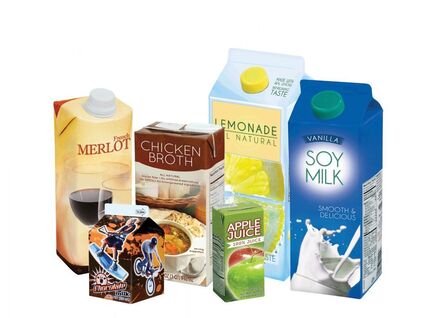Carton Recycling

What are Cartons?
Cartons are a type of packaging for food and beverage products you can purchase at the store. They are easy to recognize and are available in two types: shelf-stable, which are found on grocery store shelves, and refrigerated, which are found in the refrigerated section of grocery stores. Both types of cartons can be recycled
|
Cartons on shelves include:
● Juice ● Milk ● Soy milk ● Soup ● Broth ● Wine ● Beans |
Refrigerated cartons include:
● Milk ● Juice ● Cream ● Liquid eggs |
How to recycle cartons:
Recycling cartons is as easy as 1-2-3:
1. Empty your food and beverage cartons. (Pro tip: No need to rinse as long as you shake all those last drops of liquid or food out; this avoids having spoiled food or drink make a mess of your recycling at home or at the recycling facility)
2. Add cartons to your recycling bin with other glass, metal and plastic containers. (Pro tips: don’t crush your cartons, keep the caps on, and push your straw back into those small milk or juice cartons);
3. Take your recycling bin to the curb on collection day. What happens to recycled cartons? Once the cartons are collected, they are separated from other recyclable materials at the recycling sorting center.
What Happens to them? Why Bother?:
From there, they are either used to create paper products, such as paper towels and tissues, or building materials, such as ceiling tiles and roof cover board. In order to make paper products, the carton components are packed together and sent to a paper mill, where the cartons are added to a large machine called a Hydrapulper that breaks the cartons down into component parts. The paper pulp is separated to make paper products, while the plastic and aluminum can be sent on for further recycling or used for energy to fuel the paper mill. To make building materials, cartons go straight to a recycling company rather than being sent to the paper mill. All of the cartons, including the caps, are shredded into a million pieces and then pressed back together to create large sheets. Those sheets then become roof cover board and ceiling tiles and are used in building materials
Recycling cartons is as easy as 1-2-3:
1. Empty your food and beverage cartons. (Pro tip: No need to rinse as long as you shake all those last drops of liquid or food out; this avoids having spoiled food or drink make a mess of your recycling at home or at the recycling facility)
2. Add cartons to your recycling bin with other glass, metal and plastic containers. (Pro tips: don’t crush your cartons, keep the caps on, and push your straw back into those small milk or juice cartons);
3. Take your recycling bin to the curb on collection day. What happens to recycled cartons? Once the cartons are collected, they are separated from other recyclable materials at the recycling sorting center.
What Happens to them? Why Bother?:
From there, they are either used to create paper products, such as paper towels and tissues, or building materials, such as ceiling tiles and roof cover board. In order to make paper products, the carton components are packed together and sent to a paper mill, where the cartons are added to a large machine called a Hydrapulper that breaks the cartons down into component parts. The paper pulp is separated to make paper products, while the plastic and aluminum can be sent on for further recycling or used for energy to fuel the paper mill. To make building materials, cartons go straight to a recycling company rather than being sent to the paper mill. All of the cartons, including the caps, are shredded into a million pieces and then pressed back together to create large sheets. Those sheets then become roof cover board and ceiling tiles and are used in building materials